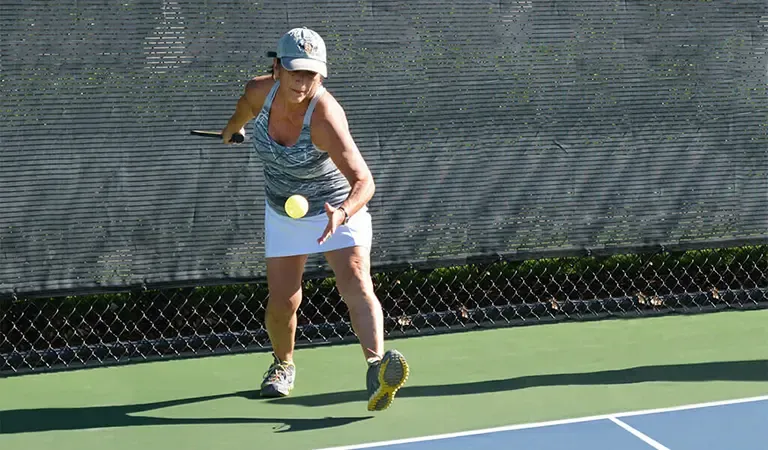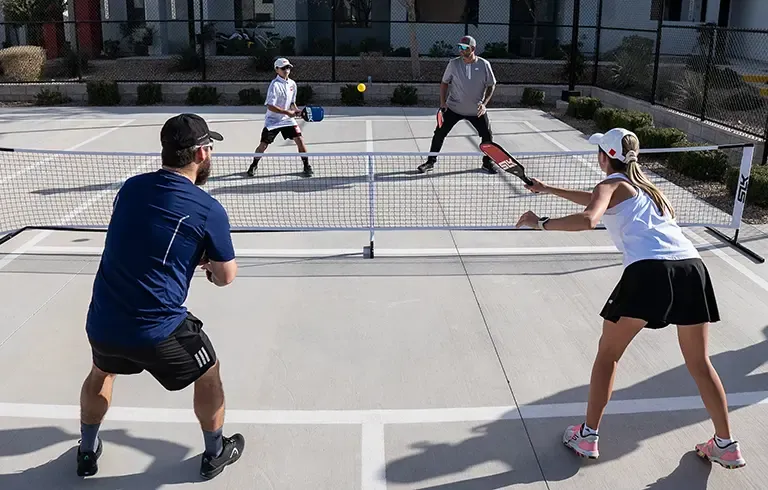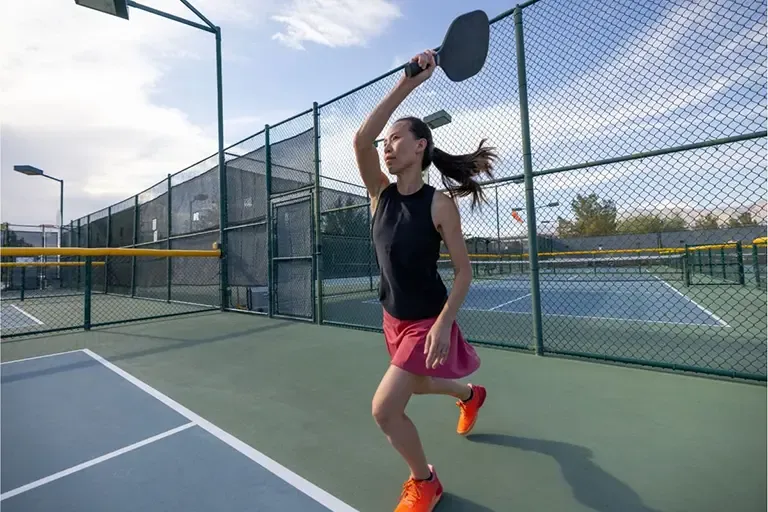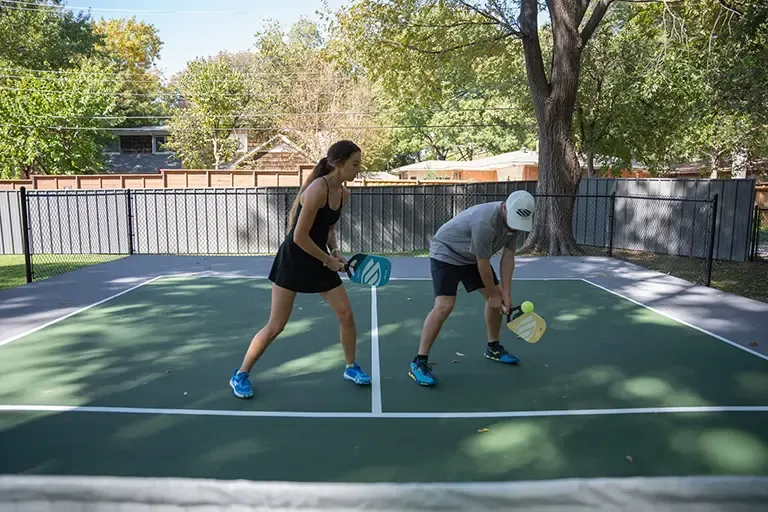Serving Court and Baseline
Understanding the playing field is paramount for any aspiring pickleball player. The western adage "Know your ground" rings especially true in our game. The serving court is marked with distinct lines that dictate not just where the ball must land, but where the server must stand. The dimensions of a pickleball court are 20 feet wide and 44 feet long for doubles play, with specific sections allocated for service. The baseline, running parallel to the net, serves as a critical reference point for the server.
Serving Court Dimensions and Layout
The overall layout of the pickleball court is designed for optimal play. The serving area is the part of the court where critical strategic plays are established. Being aware of the dimensions is vital as it helps players navigate their serves effectively.
- Width of the Service Court: 10 feet (for each side)
- Length of the Service Court: 15 feet (from the non-volley zone line to the baseline)
Importance of Staying Behind the Baseline
The baseline is not just a physical line; it's a psychological barrier that must be respected. When serving, standing behind the baseline with at least one foot on the ground establishes your readiness and balance. It prevents you from being penalized for foot faults, which occur when a player steps on or over the baseline during service. This simple yet vital rule can change the flow of the game and frustrate players who don’t adhere to it.
Foot Placement and Stance
In the dynamic world of pickleball, the importance of proper foot placement and stance cannot be overstated. The way you position your feet not only affects your balance but also shapes your ability to deliver effective serves. Imagine a tree firmly planted in the ground, swaying but never falling – this is what your foot placement should aspire to be.

Recommended Foot Placement for Serving
The ideal foot placement for serving is shoulder-width apart. This stance provides a solid base, crucial for both balance and movement. When preparing to serve, ensure that your weight is slightly forward. This will enable a quick transfer of weight as you initiate your serve, akin to a wind-up before launching a powerful shot.
Proper Stance: Balanced and Ready to Move
A balanced stance prepares you not just for the serve, but also for the return. This readiness is essential in a game characterized by fast exchanges. Use your knees slightly bent to enhance stability, enabling you to pivot or move dynamically to follow up on your serve.
Positioning for Different Serve Types (Power vs. Placement)
Depending on whether you aim for power or placement, your foot positioning can change slightly. For a power serve, a more aggressive forward weight distribution aids in maximizing impact, while a placement serve may require a more stable stance to ensure control.
- Power Serves: Leaning slightly forward, focus on your core for a strong swing.
- Placement Serves: Maintain a balanced stance, allowing for precise angles and better control.
Mastering foot placement and stance sets the groundwork for a successful serve. The ability to adapt your position based on the type of serve you want to deliver can significantly affect your effectiveness on the court.
Body Orientation and Paddle Position
The orientation of your body and the position of your paddle are crucial elements that contribute to an effective serve. Think of your body as a bow, with your paddle as the arrow you are about to unleash.

Facing the Service Court Diagonally
When preparing to serve, your body should face the service court at a slight angle. This diagonal stance not only helps in directing the ball where you want it to go but also allows your body to generate more power. Imagine being in a coiled position, ready to uncoil and propel the ball with precision.
Paddle Position: Ready for Contact with the Ball
With your paddle positioned in front of your body, you create a strong readiness to make contact. Ensure that the grip on your paddle is comfortable yet firm. A relaxed yet prepared grip allows for better control when making contact with the ball.
Ensuring a Stable Base for the Swing
As with any athletic effort, stability during your swing is crucial. Engage your core for additional stability, allowing your body to act as a full unit. By keeping your feet planted and your paddle steady, you are better equipped to execute a powerful and accurate serve.
Keeping a consistent body orientation and paddle position works towards developing a repetitive serving motion that can yield beneficial results on the court. This awareness allows you to serve with confidence and precision.
Serving Technique and Motion
The art of serving lies in the specific technique and motion executed with precision and control. The nature of pickleball requires that the serve is executed underhand, which sets it apart from many other racquet sports.

Underhand Motion: The Only Legal Serve
When preparing to serve, the underhand motion is not just legal; it’s an essential part of your serving identity. Picture a gentle upward arc as you prepare to strike the ball, emphasizing smoothness over brute force. Remember, the serve must be executed with the ball positioned below your waist.
Contact Point Below the Waist
It's vital to maintain a contact point for the ball that is below your waist. This requirement is integral to the rules of pickleball. When you achieve this position, it should feel like you're inviting the ball into your swing, rather than striking it forcibly.
Smooth and Controlled Swing with Follow-Through
A smooth follow-through is essential for maintaining control over your shot. Allow your arm to extend naturally after striking the ball, fully embracing the motion. Think of this as completing a circle. A strong follow-through enhances your momentum and adds accuracy to your serve, reducing the chances of hitting the ball out of bounds.
Mastering serving technique and motion transforms your gameplay. Practicing these aspects hones your skills, allowing you to take your serving to the next level.
Common Serving Faults and How to Avoid Them
Even the best players face challenges, and understanding common serving faults is essential for any pickleball enthusiast.

Foot Fault: Stepping on or Over the Baseline
A classic error among novice players involves the dreaded foot fault. Make a mental note that before serving, at least one foot must be touching the ground behind the baseline. Practice this mindful positioning to avoid penalties that could cost points.
Service Fault: Ball Landing Out of Bounds
A service fault occurs when the ball lands outside the designated service area. To avoid this, practice your aiming techniques, and visualize your target area before serving. A strong focus on accuracy can mean the difference between a point won or lost.
Kitchen Fault: Hitting the Non-Volley Zone
The kitchen, or non-volley zone, poses its own set of challenges. To avoid kitchen faults, emphasize landing the ball just beyond the 7-foot mark from the net. Knowing where this line lies can influence your strategy significantly during clutch moments in a game.
Recognizing and avoiding common serving faults can optimize your performance on the court. Adjusting your approach based on these aspects results in a more reliable serving game and increased confidence.
Strategies for Effective Serve Positioning
Navigating the intricacies of effective serve positioning requires strategy and thoughtful action. The landscape of pickleball is dynamic, and understanding the tactical side of your serve can dramatically alter the game flow.
Utilizing the Entire Width of the Service Court
A key strategy lies in maximizing the width of the service court. By strategically targeting different sections of your opponent’s court, you enhance your ability to create pressure and manipulation. Think of your serve as a brushstroke on a canvas; using the full width can create diverse and colorful plays.
Targeting Different Areas of the Opponent's Court
Consider targeting the sidelines or deep service areas. By varying the location of your serves, you can keep your opponent guessing, which can lead to unforced errors on their part. Imagine being a magician, leading them on a wild chase while you maintain control of the situation.
Adding Deception and Variety to the Serve
Incorporate various types of serves flat serves, soft serves, and drop serves to create unforeseen challenges for your opponent. The element of surprise can be a significant advantage in competitive play, similar to a well-placed chess move that cages an opponent's strategy.
Implementing strategic serve positioning allows players to gain an upper hand. Through awareness, targeting, and adaptability, you can refine your serve game and maximize your effectiveness on the court.
Conclusion
In summary, the pickleball serve position is an integral aspect of pickleball strategy, setting the tone for the rally and influencing the entire game. By mastering the various elements including court knowledge, foot placement, technique, and strategic positioning you can significantly improve your serve game and overall performance. The journey to perfecting your serve requires dedication, patience, and practice. So embrace the challenge and harness your potential on the court; it’s time to perfect the art of serving and take control of every point!










